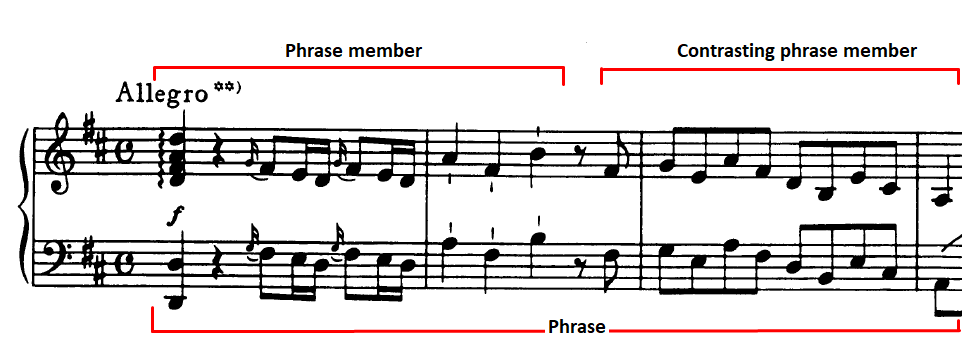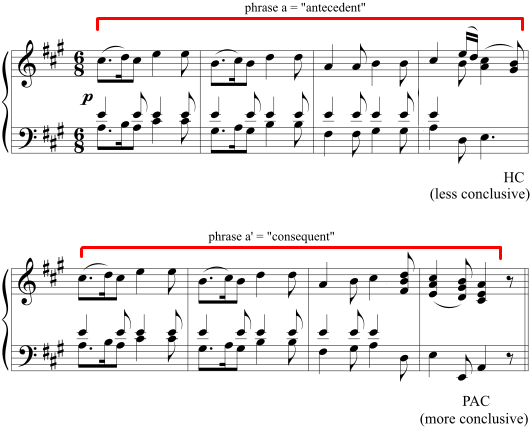
Phrases
For our story to continue, we must move beyond the subject and provide more action and context. In language, this moves to the level of a clause (dependent or independent). In music, phrase members may be combined to make a phrase.
| Language | Music | |
| Level 1 | Letter | Note |
| Level 2 | Subject | Motive |
| Level 3 | Phrase | Phrase member |
| Level 4 | Clause | Phrase |
When musicians use the term "phrase," they often mean a melodic passage, often identified by phrase markings, melodic context, or an idea under a single breath. In common practice period music and folk melodies, phrases are usually four measures in length. This is just a general guideline-a theoretical definition, not a requirement. Later, we will look at examples and methods of making phrases longer or shorter.
Phrases are usually a combination of developed motives and phrase members. A phrase is usually made up of two adjacent phrase members that have either been repeated, sequenced, or contrasted. Phrases usually end with a feeling of rest-an implied cadence-as if they were followed by a comma, semicolon, or period.
Repeated Phrase Member
A repeated phrase member is a specific component or segment within a musical phrase that is repeated identically or with slight variations. It is a distinct musical idea or passage that recurs within the larger structure of the phrase. The repetition of a phrase member creates a sense of familiarity and reinforces the musical material, contributing to the overall coherence and structure of the composition. Repeated phrase members can be melodic, rhythmic, or harmonic in nature.
Sequenced Phrase Member
A sequenced phrase member is a specific component or segment within a musical phrase that is repeated at a different pitch level, typically in a stepwise or intervallic pattern. It involves the systematic transposition or replication of a melodic or rhythmic idea, creating a sense of musical sequence. Sequencing adds variation and interest to the phrase by introducing a pattern of ascending or descending motion. It contributes to the development and structure of the music, providing continuity and coherence. Sequenced phrase members are a common technique used in composition to create musical motifs and thematic connections within a piece.
Composer: Franz Joseph Haydn
-
"Piano Trio in G Major, Hob. XV:25 "Gypsy Rondo": III. Rondo all'ongarese. Presto" [ 00:00-00:04 ]00:03
Haydn: Piano Trio in G Major, Hob. XV:25 "Gypsy Rondo": III. Rondo all'ongarese. Presto
View/Download
Composer: Franz Joseph Haydn
-
"Piano Trio in G Major, Hob. XV:25 "Gypsy Rondo": III. Rondo all'ongarese. Presto (Complete)"
Contrasting Phrase Member
A contrasting phrase member is a specific component or segment within a musical phrase that presents contrasting musical material in relation to the preceding or subsequent material. It introduces a distinct melodic, harmonic, or rhythmic idea that deviates from the established theme or motif. Contrasting phrase members serve to create variety, tension, or expressive contrast within a musical composition. They contribute to the overall musical narrative by providing moments of divergence or departure from the established musical ideas, enhancing the dynamics and emotional impact of the music.
Composer: Wolfgang Amadeus Mozart
-
"Piano Sonata No. 6 in D Major, K. 284: I. Allegro - mm.1-4" [ 00:00-00:06 ]00:06
Composer: Wolfgang Amadeus Mozart
-
"Piano Sonata No. 6 in D Major, K. 284: I. Allegro"
Antecedents and Consequents
A phrase that ends with a less conclusive cadence, e.g., a half cadence (HC), is called an antecedent, while a phrase that ends with a more conclusive cadence is called a consequent. Sometimes, an antecedent-consequent phrase pair is said to have a "question and answer" relationship.
Composer: Wolfgang Amadeus Mozart
-
"Mozart: Piano Sonata in A Major, K.V. 331, I: Andante grazioso, mm. 1-4 (Antecedent Phrase)" [ 00:00-00:11 ]00:11
Composer: Wolfgang Amadeus Mozart
-
"Mozart: Piano Sonata in A Major, K.V. 331, I: Andante grazioso, mm. 4-8 (Consequent Phrase)" [ 00:12-00:22 ]00:11
Composer: Wolfgang Amadeus Mozart
-
"Piano Sonata No. 11 in A Major, K. 331: I. Andante grazioso (Complete)"
In compositions from the Classical era, phrases are commonly either four or eight measures in length. It is typical for phrases of the same duration to occur one after another, forming patterns like 4 + 4 or 8 + 8. This regularity sets Classical style apart from the Baroque era, where phrase lengths often vary from one another.
Let's play with our motives and phrase members to create some phrases:
As you can see, our motives and phrase members may be repeated, sequenced, and contrasted in a variety of different ways to create interesting melodic passages. However, phrases do not need to be four measures in length. We can lengthen or shorten the lengths of our phrases using phrase extensions and compressions.
Phrase Extensions
The lengths of phrases may be extended beyond the typical four measures. This is usually accomplished with additional repetitions or sequences of parts of the phrase, either at the beginning, middle, or end.
Extensions at the beginning

Haydn: Symphony No. 104, III: Menuetto Allegro, mm. 53-58
Composer: Franz Joseph Haydn
-
"Symphony No. 104 in D Major, Hob. I:104 "London": III. Menuetto Allegro, mm. 53-58" [ 01:58-02:06 ]00:08
Composer: Franz Joseph Haydn
-
"Symphony No. 104 in D Major, Hob. I:104 "London": III. Menuetto Allegro"
Extensions in the middle

Haydn: Symphony No. 101. I: Adagio, mm. 26-35
Composer: Franz Joseph Haydn
-
"Symphony No. 101 in D Major, Hob. I:101 "The Clock": I. Adagio - Presto, mm. 26-35" [ 01:51-01:59 ]00:08
Composer: Franz Joseph Haydn
-
"Symphony No. 101 in D Major, Hob. I:101 "The Clock": I. Adagio - Presto"
Extensions at the end
Composer: Daniel Gottlob Turk
-
"Hunting Horns and the Echo" [ 00:00-00:10 ]00:10
Composer: Daniel Gottlob Turk
-
"Hunting Horns and the Echo"
Let's play with our phrases and add phrase extensions:
Phrase Compressions (Truncation)
Just as we can add measures to a phrase and create a phrase extension, we could also eliminate a measure to make a compressed phrase. Compressed phrases are usually created by eliminating any sort of repetition or sequence to a motive or phrase member. A compressed phrase sounds as if it is a complete phrase but is truncated.
Core Skill
- Identify and describe the different elements of musical phrases.
- Identify musical phrases quickly and accurately.





